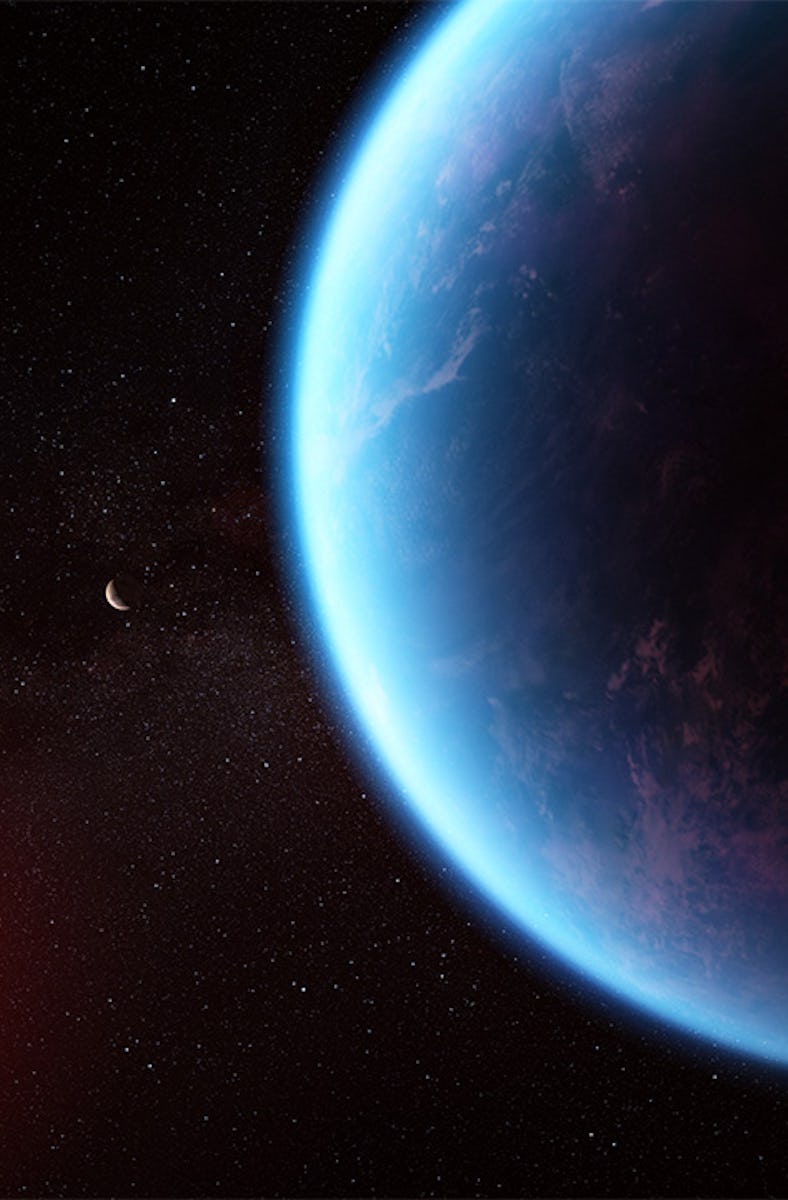The Webb Telescope Just Found Evidence Of An Alien World Covered By Water
Get excited, but not too excited, because it's going to take a lot more time and data to confirm what a team of astronomers says they've found on planet K2-18b.

We may find alien life on a planet unlike any place in our Solar System — and we may find it soon.
A huge planet called K2-18b has methane and carbon dioxide mixed in with its mostly hydrogen atmosphere, according to recent data from the James Webb Space Telescope. Those chemicals are what simulations predict astronomers should find in the atmosphere if the planet has an ocean of liquid water on its surface. The team of astronomers, led by University of Cambridge astronomer Nikku Madhusudhan, may have also found traces of a molecule that, here on Earth, is only produced by life.
“Traditionally, the search for life on exoplanets has focused primarily on smaller rocky planets, but the larger Hycean worlds are significantly more conducive to atmospheric observations,” says Madhusudhan in a recent statement. Madhusudhan and his colleagues will publish their work in The Astrophysical Journal Letters.
This artist’s illustration shows what K2-18b might look like, with its dim red star in the background.
An Enormous Ocean World
Madhusudhan and his colleagues used JWST’s Near InfraRed Slitless Spectrograph (NIRISS) and Near InfraRed Spectrograph (NIRSpec) to watch the planet pass in front of its star. As starlight filtered through the planet’s hydrogen atmosphere, the JWST instruments measured the individual wavelengths of that light. Since every chemical compound absorbs and emits different, specific wavelengths of light, JWST’s instruments could measure the wavelengths of starlight filtering through the planet’s atmosphere to reveal its chemical makeup.
And K2-18b’s atmosphere turned out to be mostly hydrogen, with about 1 percent methane and about 1 percent carbon dioxide — exactly what Madhusudhan and his colleagues say the atmosphere should look like if an ocean of liquid water lay beneath it.
K2-18b orbits in the habitable zone of a red dwarf star called K2-18: the area around a star where temperatures on a planet’s surface should be just right for liquid water, and maybe life, to exist. The planet is about 2.6 times as wide as Earth but 8.6 times more massive, which makes it an unusual type of planet called a sub-Neptune: something much larger than Earth but still smaller than Neptune. No such worlds exist in our Solar System, but they’re very common in the rest of the galaxy. And some of them, according to Madhusudhan and his colleagues, may be ocean worlds insulated by thick blankets of hydrogen gas.
These so-called “Hycean worlds” (a portmanteau of “hydrogen” and “ocean”) are sub-Neptunes whose entire surface is an ocean of liquid water, churning beneath hydrogen skies. The hydrogen atmosphere helps insulate the planet’s surface, keeping the temperature right for liquid water for billions of years even at great distances from a host star. If later observations with JWST confirm what Madhusudhan and his colleagues recently saw, this could be the first Hycean world ever discovered — and the first evidence of liquid water on a planet orbiting another star.
Madhusudhan and his colleagues also plan more observations with NIRSpec, to confirm their findings of methane and carbon dioxide in more detail and learn about the environment on K2-18b.
This graph shows the chemicals detected in K2-18b’s atmosphere.
Habitable or Actually Inhabited?
There’s a chance K2-18b could be not just habitable but actually home to alien life.
The JWST data also included possible evidence of a chemical compound called dimethyl sulfide. Here on Earth, dimethyl sulfide is mostly exhaled by marine phytoplankton, and we don’t know of anything other than life that produces it. Madhusudhan and his colleagues say they can’t be entirely sure that the signature they’re seeing in the JWST data is definitely dimethyl sulfide; in their recent paper, the astronomers describe the signal as “marginal” but say there’s “a non-negligible chance” that it’s real.
Madhusudhan and his colleagues plan to take another good look at K2-18b with another JWST instrument, the Mid InfraRed Instrument (MIRI). MIRI will measure the light filtering through K2-18b’s atmosphere in mid-infrared, which has slightly longer wavelengths than the near-infrared light they’ve already measured. That data should allow Madhusudhan and his colleagues to confirm that what they see is dimethyl sulfide — if, of course, it’s actually there.
But even if MIRI also finds evidence of dimethyl sulfide floating around in K2-18b’s atmosphere, it could lead scientists to discover some new chemical or geological process that makes the chemical (which would be very interesting in its own right), not aliens. Only time, and more data, will tell.
Meanwhile, astronomers are still trying to figure out whether smaller, more Earth-like worlds orbiting similar stars can manage to hold onto their atmospheres at all. Larger worlds like K2-18b have an advantage on that front thanks to their stronger gravity — which is one reason they may become so important in the search for life. Madhusudhan and his colleagues plan to make similar observations of other potential Hycean worlds around red dwarf stars, looking for evidence of oceans and maybe even life.
After all, it’s never aliens. That is until it is.